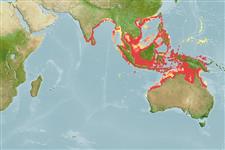Environment: milieu / climate zone / пределы глубины / distribution range
экология
морской ассоциированный с рифами; пределы глубины 2 - 80 m (Ref. 90102). Tropical; 24°N - 25°S, 75°E - 149°E (Ref. 55)
Western Indian Ocean: Mozambique (Ref. 41878). Indo-West Pacific: southern India and Sri Lanka to Philippines, New Guinea and Australia. Has been referred to as Lutjanus janthinuropterus and Lutjanus rangus (a junior synonym of Lutjanus bohar) by previous authors.
Size / Вес / Возраст
половая зрелость: Lm ? range ? - ? cm
Max length : 92.0 cm TL самец/пол неопределен; (Ref. 132370); common length : 35.0 cm TL самец/пол неопределен; (Ref. 55); наибольший вес (опубликованные данные): 12.5 kg (Ref. 132370)
колючие лучи спинного плавника (общее число) : 10; членистые (мягкие) лучи спинного плавника (общее число) : 13 - 14; колючие лучи анального плавника: 3; членистые (мягкие) лучи анального плавника: 8. Dorsal profile of head steeply sloped, snout profile slightly concave. Preorbital bone usually much greater than eye diameter, at least in large specimens. Preopercular notch and knob poorly developed. Scale rows on back rising obliquely above lateral line. Generally gray-brown or olive on the upper portion of the back and head, grading to whitish ventrally. The dorsal and caudal fins are dusky brown or black, frequently with a narrow white posterior margin. The anal, pelvic and pectoral fins are whitish with some dusky brown. Juveniles have a broad black horizontal band from snout tip to caudal fin base. Large juveniles with black mid-lateral stripe. Adults plain pinkish brown with dusky tail (Ref. 48635). Body depth 2.5-2.8 in SL (Ref. 90102).
Body shape (shape guide): fusiform / normal; Cross section: oval.
Solitary or in small groups (Ref. 90102). Adults inhabit offshore reefs and muddy habitats. Juveniles are sometimes found in the vicinity of coral reefs, often located close to the shore where silting is moderate and visibility is reduced. Adults usually very deep (Ref. 48635). They feed on fishes and a variety of benthic invertebrates.
Life cycle and mating behavior
половая зрелость | размножение | нерест | икра | Fecundity | личинки
Allen, G.R., 1985. FAO Species Catalogue. Vol. 6. Snappers of the world. An annotated and illustrated catalogue of lutjanid species known to date. FAO Fish. Synop. 125(6):208 p. Rome: FAO. (Ref. 55)
Статус Красного Списка МСОП (Ref. 130435: Version 2025-1)
Угроза для людей
Harmless
Использование человеком
рыболовство: коммерческий
дополнительная информация
инструменты
Специальные отчеты
Скачать в формате XML
ресурсы в Интернет
Estimates based on models
Preferred temperature (ссылка
123201): 26.3 - 29.1, mean 28.3 °C (based on 1226 cells).
Phylogenetic diversity index (ссылка
82804): PD
50 = 0.5000 [Uniqueness, from 0.5 = low to 2.0 = high].
Bayesian length-weight: a=0.01479 (0.00706 - 0.03101), b=2.97 (2.80 - 3.14), in cm total length, based on LWR estimates for this Genus-body shape (Ref.
93245).
Trophic level (ссылка
69278): 4.0 ±0.65 se; based on food items.
устойчивость к внешним воздействиям (ссылка
120179): низкий, минимальное время удвоения популяции 4.5-14 лет (Preliminary K or Fecundity.).
Fishing Vulnerability (Ref.
59153): High vulnerability (57 of 100).
🛈
Nutrients (Ref.
124155): Calcium = 27.2 [17.9, 38.8] mg/100g; Iron = 0.301 [0.196, 0.449] mg/100g; Protein = 18.6 [17.1, 19.9] %; Omega3 = 0.129 [0.094, 0.173] g/100g; Selenium = 67.3 [46.9, 95.6] μg/100g; VitaminA = 127 [24, 444] μg/100g; Zinc = 0.403 [0.331, 0.546] mg/100g (wet weight);
